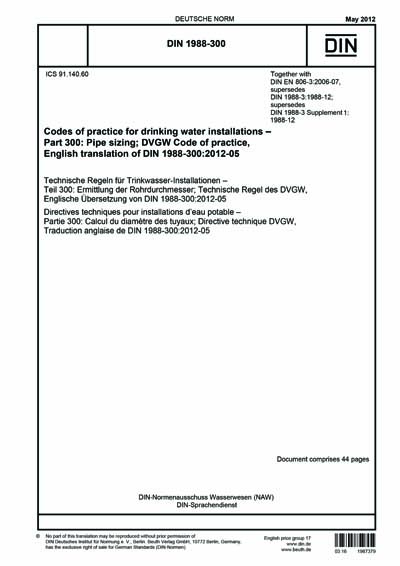Most recent
DIN 1988-300:2012
Codes of practice for drinking water installations - Part 300: Pipe sizing; DVGW code of practice
The standard specifies the basis and the methods for the calculation of the pipe diameters of drinking water installations in buildings and properties.*This standard has been prepared by Working Committee NA 119-04-07 AA "Häusliche Wasserversorgung" ("Domestic water supply") at the Water Practice Standards Committee (NAW). After a set of European Standards has been prepared by Technical Committee CEN/TC 164 "Water supply" and been adopted as DIN EN standards into the German body of standards, the task for the Committee was to check the content of the standard series DIN 1988 on "Codes of practice for drinking water installations" and to develop a concept for a comprehensive self-contained and consistent replacement document. The European work results do not reach the required standardization depth for the German user groups and therefore it became necessary to prepare, on a delayed basis, additional specifications for Germany which are published again for continuity reasons under the number DIN 1988, taking into account European deadlines. In order to clearly show the expert community that this is a "new" series of DIN 1988, three-digit part numbers were chosen. The aim of every design of cold and hot water pipes is to ensure the minimum flow rate at all draw-off points at peak load of the system at the smallest possible internal diameters. The future standard applies in conjunction with the series DIN 1988 and DIN EN 806-2 for the planning, erection, modification, maintenance and operation of drinking water installations in buildings and on properties and serves for the determination of the tube diameter for the drinking water pipes as well as for the determination of component sizes (return pipes, pumps, throttle valves) for a circulation system. For more than two decades planners and executing persons have had positive experience with the calculation methods of DIN 1988-3:1988-12. For this reason, the core of the differentiated calculation method for the determination of the tube diameter for cold and hot water pipes has been adopted into this standard, but with the updated values for the calculation flow rate and peak flows, friction coefficients of so-called single resistors, etcetera. Furthermore, the circulation systems in this standard are designed, on the basis of a load calculation, with the aim to maintain the hot water temperatures at at least 55 °C in all circulation paths of the system at minimum possible water content. The differentiated calculation method given in this standard shall be applied to all types of buildings. Only the tube diameter for the cold and hot water pipes in buildings with up to six flats can also be determined in accordance with DIN EN 806-3 provided that there is sufficient service pressure and hygiene is ensured. The most important modifications compared to the previous edition are as follows: adaptation of the peak volume flow rates to the current conditions and introduction of utilization units for better determination of the end-line peak loads (for example, at floor levels), start of the design of pipelines downstream the water meter; the minimum pressure downstream the water meter indicated by the water supplier shall be used, the termination of so-called simplified calculation methods; only the given reference values for the single resistors are allowed to be used for product neutral tendering, plausibility check of the reference values in accordance with this standard (for example, for the minimum flow pressure) by a comparison with the manufacturer information, consideration of temperature-dependent material values, decrease of the calculation flow rates of washing machines and dishwashers, differentiated calculation of the ring line in the floor distribution of utilization units as well as modified calculation of the circulation systems with the aim to realize the hygiene requirements at minimum plant-specific and energetic efforts. Furthermore, it is not the intention to give example calculations for typical drinking water installations and value tables for certain calculation parameters. The reason is that for installation calculations suitable software is available which is widely used.
Content Provider
Deutsches Institut für Normung [din]






